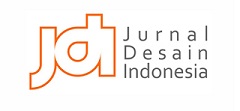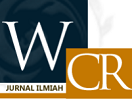DISTORSI SEJARAH DAN PERSEPSI VISUAL: STUDI KASUS ANIMASI POCAHONTAS
Abstract
As a form of children's literature, animated films are reflective illustrations of real life whose consumers are segmented as children. However, children's literary production is often ambivalent. The reason is that children's literature must arouse the imagination (in order to fulfill the elements of literature) while depicting real life that represents facts (in order to fulfill the requirements for reflection and representation of life). If animation is used to retell past history, then the major premise narrated by the animation must be representative of actual events (valid in terms of the information source). This research seeks to achieve two things, namely: discussing the extent of historical distortion in the Pocahontas animation as literature, and revealing the audience's meaning of the message content in the Pocahontas animation. This research was carried out qualitatively using the structuralism semiotic analysis method introduced by Ferdinand de Saussure. The results of this research reveal that the historical reconstruction in the Pocahontas animation is indeed distorted. However, this deviation is still at a normal stage as children's literature. The Pocahontas animation does not qualify as a historical reconstruction. It only qualifies as children's literature intended for entertainment purposes. Moreover, there is the addition of the wrong romantic element. According to a semiotic analysis of audience perception, this distortion is not a serious problem for viewers in Indonesia (who incidentally do not know the historical events behind the character Pocahontas). Meanwhile, for Americans, especially native Americans, this distortion is an ethical problem that literary producers and critics need to pay attention to.
Keywords
Full Text:
PDF (Bahasa Indonesia)References
Adzani, F., & Murwonugroho, W. (2021). Pentingnya kesesuaian visual karakter tokoh dalam film animasi “My little pony: The movie.” Jurnal Penelitian Dan Karya Ilmiah Lembaga Penelitian Universitas Trisakti, 6(1), 68–84.
DOI:https://doi.org/10.25105/pdk.v6i1.8630
Andelina, I. R. (2020). Analisis elemen dalam penciptaan karakter desain di dalam Ip Hypnosis Mic - Seiyuu X Rapper Project. Narada Jurnal Desain Dan Seni, 7(2), 137.
DOI:https://doi.org/10.22441/narada.2020.v7.i2.001
Buescher, D. T., & Ono, K. A. (2015). Civilized colonialism: Pocahontas as neocolonial rhetoric. Women’s Studies in Communication, 19(2), 127–153.
DOI:https://doi.org/10.1080/07491409.1996.11089810
Byrskog, S. (2002). Story as history - history as story. Boston, Leiden: Brill Academic Publishers.
Clément, T. (2020). The art of Walt Disney animation studios: Movement by nature. InMedia: The French Journal of Media Studies, 6.
DOI:https://doi.org/10.4000/inmedia.877
Feest, C. F. (2007). Native Americans, history and the environment. In U. Lehmkuhl & H. Wellenreuther (Eds.), Historians and nature (Issue March). Berg.
Feest, C. F., & Mossiker, F. (1977). Pocahontas: The life and the legend. Ethnohistory, 24(3), 272.
DOI:https://doi.org/10.2307/481702
Huber, M. W. (2013). Pocahontas and Rebecca : Two tales of a captive. Proceedings of the Annual Meeting of the Southern Anthropological Society, 42(1), 75–102.
Kartodirdjo, S. (1992). Pendekatan ilmu sosial dalam metodologi sejarah. Jakarta: Gramedia Pustaka Utama.
Kuntowijoyo. (2013). Pengantar ilmu sejarah. Yogyakarta: Tiara Wacana.
Kupperman, K. O. (2019). Pocahontas and the English boys: Caught between cultures in early Virginia. New York University Press.
M. Wardaya, AI Saidi, W.Murwonugroho. Karakteristik Buku Anak yang Memorable dalam Membangun Karakter Anak. Jurnal Seni & Reka Rancang. 2(2), April 2020, pp 199-206.
DOI:https://doi.org/10.25105/jsrr.v2i2.8233
Miftakhuddin, M. (2020). Kolonialisme: Eksploitasi dan pembangunan menuju hegemoni. Sukabumi: Jejak.
Miles, M. B., Huberman, A. M., & Saldana, J. (2014). Qualitative data analysis: A methods sourcebook (3rd ed.). United State: Sage Publication.
Mitchell, D., Waterbury, P., & Casement, R. (2002). Children’s literature: An invitation to the world. Boston: Allyn and Bacon.
Montón, L. S. J. (2020). "Pocahontas: A Study of Disney’s Approach to English Colonialism". [Thesis]. Spanyol: Filología Inglesa y Alemana y Traducción e Interpretación, Universidad Del País Vasco.
NABS Research Center Online Exhibits. (2010). The true story of Pocahontas. United State: Salisbury University Libraries.https://libapps.salisbury.edu/nabb-online/exhibits/show/native-americans-then-and-now/introduction/how-is-indigenous-history-port/the-true-story-of-pocahontas#:~:text=Pocahontas is one story that,portray or represent historical events.
Nurgiyantoro, B. (2016). Sastra anak: Pengantar pemahaman dunia anak. Yogyakarta: Gadjah Mada University Press.
Ocasio, G. (2012). Matoaka, one who kindles (Also known as Pocahontas). InTensions, 5(5), 1–5.
DOI:https://doi.org/10.25071/1913-5874/37375
Price, D. A. (2023). "Pocahontas: Powhatan princess". Britannica.Com, 2023, July. Chicago. Diambil dari: https://www.britannica.com/biography/Pocahontas-Powhatan-princess
Ranang, B. A. (2010). Animasi kartun dari analog sampai digital. Jakarta: Indeks.
Smith, E. B. (2008). The story of Pocahontas and captain John Smith. Project Gutenberg.
Stebbins, S. J. (2010). "Historic Jamestowne: Part of colonial national historical park virginia". National Park Service, 2010 August. Virginia. Diambil dari: https://www.nps.gov/jame/learn/historyculture/pocahontas-her-life-and-legend.htm
Stewig, J. W. (2013). Children’s preference in picture book illustration. Education Leadership Journal, 31(2), 273–279.
Swatriani, R. (2020a). Konstruksi karakter Jabo dalam animasi Binekon. Narada : Jurnal Desain Dan Seni, 7(1), 31-44
DOI:https://doi.org/10.22441/narada.2020.v7.i1.003
Swatriani, R. (2020b). Representasi budaya nusantara dalam animasi Binekon. Jurnal Narada, 7(3), 287–306.
DOI:https://doi.org/10.2241/narada.2020.v7.i3.001
Taberham, P. (2020). Defining experimental animation: A follow-up. Animation Practice, Process & Production, 8(1), 11–31.
DOI:https://doi.org/10.1386/ap3_00002_1
DOI: http://dx.doi.org/10.22441/narada.2023.v10.i2.004
Refbacks
- There are currently no refbacks.
Fakultas Desain dan Seni Kreatif
Universitas Mercu Buana
Gedung E Lantai 4
Jl. Raya Meruya Selatan no.1, Kembangan, Jakarta 11650
Tlp./Fax: +62215871335
Journal International Standard Serial Number (ISSN) Registration:
The Journal is indexed by:
Tools for Citations & Plagiarism Detection:

Ciptaan disebarluaskan di bawah Lisensi Creative Commons Atribusi-NonKomersial 4.0 Internasional
 NARADA: Jurnal Desain dan Seni
NARADA: Jurnal Desain dan Seni

























